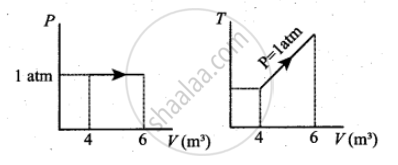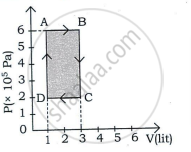Advertisements
Advertisements
प्रश्न
For a given ideal gas 6 × 105 J heat energy is supplied and the volume of gas is increased from 4 m3 to 6 m3 at atmospheric pressure. Calculate
- the work done by the gas
- change in internal energy of the gas
- graph this process in PV and TV diagram
उत्तर
Heat energy supplied to gas Q = 6 × 105 J
Change in volume ∆V = (6 – 4) = 2 m3
1 atm = 1.013 × 105 Nm−2
a. Work done by the gas W = P × ∆V
= 1.013 × 105 × 2
= 2.026 × 105
W = 202.6 kJ
b. Change in internal energy of the gas
∆U = Q − P. ∆V
= 6 × 105 − (202.6 × 103)
= 6 × 105 − 2.026 × 105
= 3.974 × 105
∆U = 397.4 kJ
c.

APPEARS IN
संबंधित प्रश्न
In an isochoric process, we have ____________.
Draw the PV diagram for the isochoric process.
What is meant by a reversible and irreversible processes?
Can the given heat energy be completely converted to work in a cyclic process? If not, when can the heat can completely converted to work?
Derive the work done in an isothermal process.
Among the amount of heat absorbed and the amount of work done by a system, ______
An ideal gas A and a real gas B have their volumes increased from V to 2V under isothermal conditions. The increase in internal energy ____________.
In a certain thermodynamical process, the pressure of a gas depends on its volume as kV3. The work done when the temperature changes from 100°C to 300°C will be ______ nR, where n denotes number of moles of a gas.
An ideal gas is taken through a cyclic process ABCDA as shown in figure. The net work done by the gas during the cycle is ______.

Explain how can a gas be expanded at constant temperature.
